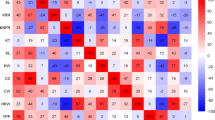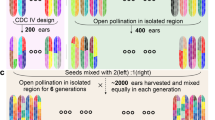Abstract
Quantitative trait loci (QTL) are most often detected through designed mapping experiments. An alternative approach is in silico mapping, whereby genes are detected using existing phenotypic and genomic databases. We explored the usefulness of in silico mapping via a mixed-model approach in maize (Zea mays L.). Specifically, our objective was to determine if the procedure gave results that were repeatable across populations. Multilocation data were obtained from the 1995–2002 hybrid testing program of Limagrain Genetics in Europe. Nine heterotic patterns comprised 22,774 single crosses. These single crosses were made from 1,266 inbreds that had data for 96 simple sequence repeat (SSR) markers. By a mixed-model approach, we estimated the general combining ability effects associated with marker alleles in each heterotic pattern. The numbers of marker loci with significant effects—37 for plant height, 24 for smut [Ustilago maydis (DC.) Cda.] resistance, and 44 for grain moisture—were consistent with previous results from designed mapping experiments. Each trait had many loci with small effects and few loci with large effects. For smut resistance, a marker in bin 8.05 on chromosome 8 had a significant effect in seven (out of a maximum of 18) instances. For this major QTL, the maximum effect of an allele substitution ranged from 5.4% to 41.9%, with an average of 22.0%. We conclude that in silico mapping via a mixed-model approach can detect associations that are repeatable across different populations. We speculate that in silico mapping will be more useful for gene discovery than for selection in plant breeding programs.


Similar content being viewed by others
References
Beavis WD (1994) The power and deceit of QTL mapping experiments: lessons from comparative QTL studies. Proc Corn Sorghum Ind Res Conf 49:250–266
Bernardo R (1994) Prediction of maize single-cross performance using RFLPs and information from related hybrids. Crop Sci 34:20–25
Bernardo R (1996a) Best linear unbiased prediction of maize single-cross performance. Crop Sci 36:50–56
Bernardo R (1996b) Testcross additive and dominance effects in best linear unbiased prediction of maize single-cross performance. Theor Appl Genet 93:1098–1102
Bernardo R (1998) Predicting the performance of untested single crosses: trait and marker data. In: Lamkey KR, Staub JE (eds) Concepts and breeding of heterosis in crop plants. Publ 25, Crop Science Society of America, Madison, Wis., pp 117–127
Bernardo R (1999) Marker-assisted best linear unbiased prediction of single-cross performance. Crop Sci 39:1277–1282
Bernardo R (2002) Breeding for quantitative traits in plants. Stemma Press, Woodbury, Minn.
Burnham CR, Cartledge JL (1939) Linkage relations between smut resistance and semi-sterility in maize. J Am Soc Agron 31:924–933
Dudley JW (1993) Molecular markers in plant improvement: manipulation of genes affecting quantitative traits. Crop Sci 33:660–668
Emik LO, Terrill CE (1949) Systematic procedures for calculating inbreeding coefficients. J Hered 40:51–55
Grupe A, Germer S, Usuka J, Aud D, Belknap JK, Klein RF, Ahluwalia MK, Higuchi R, Peltz G (2001) In silico mapping of complex disease-related traits in mice. Science 292:1915–1918
Henderson CR (1985) Best linear unbiased prediction of nonadditive genetic merits in noninbred populations. J Anim Sci 60:111–117
Johnson L (2001) Marker assisted sweet corn breeding: a model for specialty crops. Proc Corn Sorghum Ind Res Conf 56:25–30
Johnson GR (2004) Marker-assisted selection. Plant Breed Rev 24:293–309
Kearsey MJ, Farquhar AGL (1998) QTL analysis in plants; where are we now? Heredity 80:137–142
Kennedy BW, Quinton M, van Arendonk JAM (1992) Estimation of effects of single genes on quantitative traits. J Anim Sci 70:2000–2012
Kerns MR, Dudley JW, Rufener GK (1999) QTL for resistance to common rust and smut in maize. Maydica 44:37–45
Lübberstedt T, Klein D, Melchinger AE (1998) Comparative QTL mapping of resistance to Ustilago maydis across four populations of European flint-maize. Theor Appl Genet 97:1321–1330
Mackay TFC (2001) The genetic architecture of quantitative traits. Annu Rev Genet 35:303–339
Melchinger AE, Utz HF, Schön CC (1998) Quantitative trait locus (QTL) mapping using different testers and independent population samples in maize reveals low power for QTL detection and large bias in estimates of QTL effects. Genetics 149:383–403
Ooijen JW van (1992) Accuracy of mapping quantitative trait loci in autogamous species. Theor Appl Genet 84:803–811
Openshaw SJ, Frascaroli E (1997) QTL detection and marker-assisted selection for complex traits in maize. Proc Corn Sorghum Ind Res Conf 52:44–53
Panter DM, Allen FL (1995) Using best linear unbiased predictions to enhance breeding for yield in soybean: I. Choosing parents. Crop Sci 35:397–405
Press WH, Teukolshy SA, Vetterling WT, Flannery BP (1992) Numerical recipes in Fortran: the art of scientific computing, 2nd edn. Cambridge University Press, New York
Rawlings JO, Thompson DL (1962) Performance level as criterion for the choice of maize testers. Crop Sci 2:217–220
Saboe LC, Hayes HK (1941) Genetic studies of reactions to smut and firing in maize by means of chromosomal interchanges. J Am Soc Agron 33:463–470
Smith OS, Hoard K, Shaw F, Shaw R (1999) Prediction of single-cross performance. In: Coors JG, Pandey S (eds) The genetics and exploitation of heterosis in crops. American Society of Agronomy, Crop Science Society of America, Madison pp 277–285
Visscher PM, Thompson R, Haley CS (1996) Confidence intervals in QTL mapping by bootstrapping. Genetics 143:1013–1020
White TL, Hodge GR (1989) Predicting breeding values with applications in forest tree improvement. Kluwer, Dordrecht
Author information
Authors and Affiliations
Corresponding author
Additional information
Communicated by H.C. Becker
Rights and permissions
About this article
Cite this article
Parisseaux, B., Bernardo, R. In silico mapping of quantitative trait loci in maize. Theor Appl Genet 109, 508–514 (2004). https://doi.org/10.1007/s00122-004-1666-0
Received:
Accepted:
Published:
Issue Date:
DOI: https://doi.org/10.1007/s00122-004-1666-0




